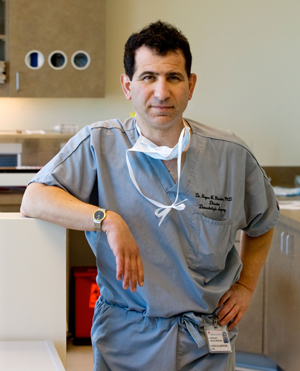September 23, 2009

Hayes Gladstone, MD, a dermatologic surgeon, is a long-time volunteer at Arbor Free Clinic.
Even before the Arbor Free Clinic in Menlo Park opens each Sunday morning, patients line up, waiting to be seen. They are people without health insurance, without enough money to pay for a doctor visit. Some may not have been to a doctor for years. But at Arbor Free, they can see Stanford physicians like Hayes B. Gladstone, MD, who has volunteered there one Sunday a month for eight years, ever since he joined the medical staff of Stanford Hospital & Clinics.
Gladstone heads the Hospital's Division of Dermatologic Surgery. He is a recognized expert in the micrographic treatment of skin cancer, minimally invasive facial surgery and soft tissue reconstruction. His research has been published dozens of times in medical journals, and he serves on the editorial board of the Journal of Dermatologic Surgery.
He is also a doctor's son who grew up in the blue-collar town of Canton, Ohio, watching his father willingly treat patients who could not always pay in cash. And both of Gladstone's parents believed that each person must contribute to fulfill his or her collective social responsibility.
Gladstone has established his own volunteer tradition, helping to start a free clinic when he was a medical student at the University of Rochester and volunteering at a free clinic when he was a resident in dermatology at the University of Washington Medical Center. In 2003, he and a colleague co-founded the Blade and Light Society, a group that arranges for dermatologic surgeon volunteers to travel to countries with inadequate health care systems and high rates of skin cancer. The Blade and Light teams work for five days, 14 to 16 hours each day.
"As doctors, we all get caught up in our daily lives and how busy we are-but then seeing others less fortunate and who have no health care brings everything into perspective," said Gladstone. "I believe that we all have a responsibility to both the community and society, and to contribute to its well-being is particularly true of the medical profession."
At the Arbor Free Clinic, Gladstone and the other volunteer physicians work with Stanford medical students, sharing many hours of their time. The volunteers that keep the clinic running "are dedicated and very idealistic," Gladstone said. All the medications are donated, and funds are always needed. "We run on a shoestring," he said. "We also need more doctors."
Gladstone knows that his time at the clinic has several values. He enjoys teaching by example, and students can learn in an environment where they spend more time with patients. They are also working with limited resources, learning how to provide basic health care.
The patients Gladstone sees have skin problems that clearly reflect their lives. They are likely to have spent time outside, whether from lack of housing or because they have done outside work for years. Under those circumstances, Gladstone said, "the skin takes a beating. Seeing the medical dermatology patients at Arbor reminds me how vulnerable the skin is to the environment."
He sees people with skin issues ranging from trenchfoot to dermatitis, and he also screens and treats patients for skin cancer.
Gladstone has a full schedule that includes his hospital practice, surgery, teaching and research. But those Sunday mornings are as important to him as his other responsibilities. Being at Arbor, he said, "you remember why you are in medicine."
About Stanford Medicine
Stanford Medicine is an integrated academic health system comprising the Stanford School of Medicine and adult and pediatric health care delivery systems. Together, they harness the full potential of biomedicine through collaborative research, education and clinical care for patients. For more information, please visit med.stanford.edu.